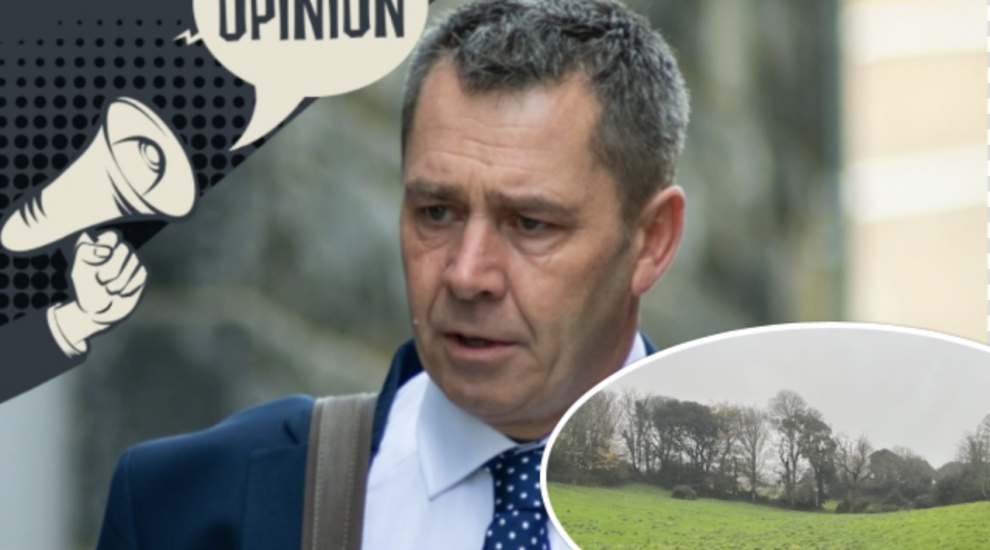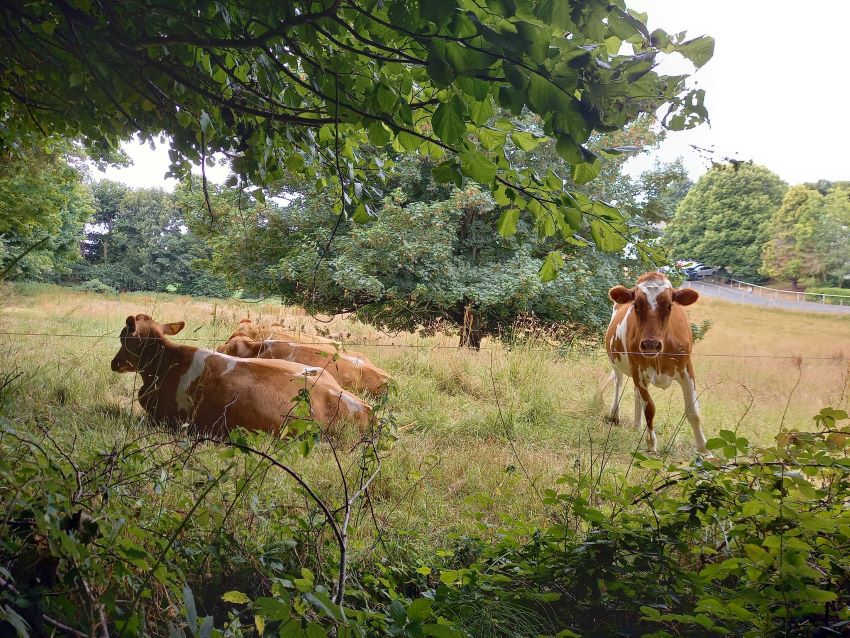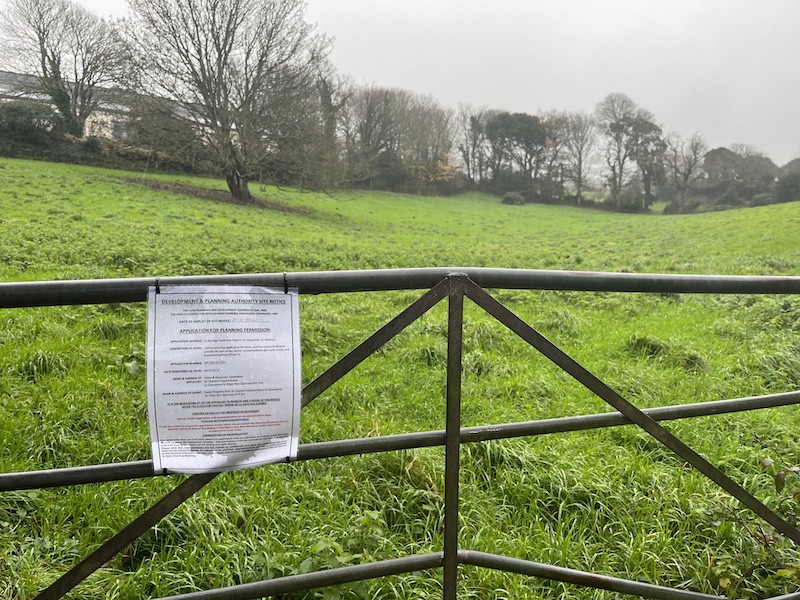


Deputy Marc Leadbeater has written an open letter explaining why he and the Committee for Health and Social Care believe the Vauqueidor field is the best option for building new housing for healthcare staff.
His letter is published in full below:

Pictured: The field within the grounds of the Princess Elizabeth Hospital is used by cattle for grazing.
Reading the media reports and social media posts from Deputy Steve Falla recently has evoked a sense of deja vu – the same thin arguments tainted with spin and exaggeration have risen again from the flames of the Requete, so I thought it best to reply and douse the fire before it spreads too far.
Back when the States debated the proposed development of desperately needed key worker accommodation on this piece of the PEH Campus, Deputy Falla lead the Requete to try and stop the proposals, and when he opened the debate and he told us three things. Those three things were, the land in question is prime agricultural land, the land is an important area for biodiversity, and that developing the Duchess of Kent (DoK) site adjacent to it would be far more cost effective than building next door as proposed.
Let’s start with his notion that the site is prime agricultural land – it is not. These words are taken from the Development & Planning Authority’s (DPA’s) letter of comment that was appended to his Requete, it states. “The field referred to in the requête measures approximately 7 vergées (c. 2.7 acres) and forms part of the eastern edge of an APA which extends west to the proximity of Rocquaine, Perelle and Vazon (as outlined in closer detail in the maps at Appendix H). The agricultural quality classification of the land is Grade 3b: Moderate quality land. The top three grades of soil are known as Grades 1, 2 and 3, with grade 3 split into two subgrades. Grade 3b is subject to a moderate degree of limitation common to all Grade 3 land, but also is subject to physical disadvantages such as gradient, which restrict its flexibility and performance to levels below that expected of subgrade 3a land, as is the case in respect of the PEH field”. So, the land is far from prime agricultural land, it is subgrade 3b land, meaning it’s only capable of producing moderate yields of a narrow range of crops, or lower yields of a wider range of crops - and regardless of what you may have heard this is a fact. If you would like to see what prime agricultural land looks like then I suggest that you look at the land adjoining to the west – that is all prime, farmed agricultural land, and it looks markedly different from the site in question.
OK, let’s look at the second thing we were told, that the site is an important area for biodiversity – well, which one is it? It can’t be prime agricultural land that should be worked and an area for flora, fauna and insects to thrive both at the same time – it can only be one or the other – and I would suggest it is neither. Take a look at a map of the area and you will see for yourself the swathes of prime agricultural land and areas of biodiversity that surround the site.

Pictured: The Duchess of Kent House is currently used for administration and management staff.
The third thing we were told is that it would cost far less to redevelop the DoK building compared with the proposal of building next door. This was complete nonsense and I pointed this out when I spoke. He was comparing the cost of building 60 units on the Duchess of Kent site with the cost of building 140 units on the proposed site. By using the exact same figures as Deputy Falla did, the actual calculation tells us that, if building comparable sized block of accommodation on the proposed site and on the DoK, the cost to redevelop the DoK comes to around £30m more – this is what I meant by thin arguments tainted by spin and exaggeration. Having to resort to twisting facts and trying to compare ormers with limpets in order to gain support for your argument is not conducive to good government in my opinion. While we are at it let’s look at the DoK and the reasons why this and other sites are not being proposed, and the process followed to determine the proposed site. The States Property Unit process considered properties within a 1km radius of the PEH and identified 14 possible sites in either States of Guernsey or private ownership. 12 of those were on or within 0.5km of the PEH, and of those, 7 were in States ownership. The sites were then scored against key criteria established by officers on behalf of HSC: That was
1. Construction of not less than 70 units (the equivalent of John Henry Court) but preferably circa 140 units.
2. On or very near to the PEH campus (within 1km).
3. Delivered immediately (circa 2-3 years, and not more than 5 years).
Options were also scored for their neighbour impact, cost, and environmental impact, the latter having regard for the brownfield or greenfield status of the land. The sites were then ranked based on their overall scores. However, sites which failed to satisfy any one of the three criteria established on behalf of HSC were deemed to not meet the essential criteria and consequently were not assigned a rank. The full scores and rankings are shown at Appendix G of the P&R Letter appended to the Requete, along with all the reasoning behind the proposal. The patch of land adjacent to the DoK, the proposed site, scored highest and was ranked first out of the 14 sites. The DoK site itself was not ranked because it did not meet the key criteria for delivery within five years, but even if all the sites had been ranked, the proposed site still would have scored highest – as summarised again at Appendix G). Contrary to some of the arguments you will have read, you can hopefully now understand that there was was a full and proper process undertaken in order to determine the best available site.

Pictured: Deputy Steve Falla is one of the opponents of building on the field, which he has used a painting to illustrate.
Another point raised consistently by some opponents is that the land is part of an Agricultural Priority Area (APA), and yes it is and nobody is denying that. But let’s look at what the Island Development Plan tells us about APA’s. “Whilst the IDP policy approach is to generally support development for agricultural purposes in APA’s these areas have been drawn broadly. The APA is not intended to safeguard land for agriculture if it is not appropriate to do so or is not required for that purpose. The IDP policy approach therefore allows for other forms of development in APA’s provided that certain criteria are met, and all other policies of the Plan are met”. So, this explains that just because a piece of land falls within an APA, that doesn’t mean it is land that it is specifically intended to be used for agricultural purposes – another myth dispelled. The DPA go on to say in the letter of comment. “The site in question is part of an Agriculture Priority Area. The preamble to Island Development Plan (IDP) Policy OC2: Social and Community Facilities Outside of the Centres, confirms at paragraph 16.2.1 that development proposals relating to large-scale strategic social and community facilities which have an Island-wide relevance, such as the hospital and schools, will be assessed against Policy S5: Development of Strategic Importance. The provision of key worker housing for health workers on or adjacent to the Hospital campus would be considered ancillary to and part of the Hospital use”. This explains why the application is to be considered through policy S5 – because our planning policy deems it so.
The debate on this subject that has been drawn out mainly over social media has focused on trying to drum up support in order to prevent the States from “concreting over prime agricultural land when there are other more appropriate sites”. But this statement and all of the others I have read could not be further from the truth. We know that the land is not prime agricultural land – fact, and we know that a full evaluation process of 14 potential sites was undertaken. Yes, there are other sites not too far away from the PEH that could provide some key worker housing, but we are so desperately short of these units that we need to develop those as well as, not instead of, the proposed site. HSC currently operates 383 units of accommodation across 49 different sites, some owned and some rented. This development would free up some rented accommodation that HSC currently uses adding more available units back onto the local market for local people, and in a relatively short space of time compared to the if using the DoK site or an old hotel for example.
Let’s consider too some of the contributors to the collective housing crisis we are facing. Last term there were two important laws brought into effect – the Island Development Plan and the Population Management Law. The IDP is effectively a massive book of policies that tell you what you can and cannot do with your land or property, and one policy within that book is GP11. Policy GP11 dictates that any development of more than 19 units of accommodation is required to provide circa 30% of those units for Social Housing. This had developers running scared – and still has. I warned about this back then and I also tried to have this policy deleted from the IDP last term but had little or no support at that time. The effect of Policy GP 11 was that developers sat on their larger sites and chose instead to target the smaller, often greenfield sites, within the main and local centres, adding far fewer units of accommodation to our housing stock than we could have if the larger ones had been brought forward. So, we have been building far fewer units than we could have since the IDP came into effect in 2016. Secondly, 2017 saw the introduction of the Population Management Law. Historically, those coming to the island to live and work in the roles that aren’t seasonal had restrictions on what property they could occupy based upon the TRP threshold. Now, anyone coming to live and work on a Medium or Long Term Employment Permit can occupy any local market dwelling they like, which in turn has squeezed the lower end of the market down to the scarce availability that we see today. These are facts that we cannot ignore, the IDP, or moreover Policy GP11, and the PML combined, have had a massive negative effect upon the availability of good quality local market housing stock.
So, you will be able to see that we do indeed have a housing crisis, and that simply being able to pick and choose the ideal sites for key worker housing in order to preserve a bit of undeveloped space on our PEH Campus is not a luxury that we are afforded. Let’s now examine the history of the site and just why it was bought by the States in the first place.

Pictured: The site notice was put up at the PEH field before Christmas.
On April 11th 1929, the Oberlands Estate was bequeathed to the States by the wonderful Reverand Peter Mignot, that area now houses the Oberlands, CAMHS and the Lighthouse Wards. Following an advert placed in 1934 for development land by the SoG, a larger parcel of land (including the valley) was acquired on 14th June 1934 from Mr Albert Gavet for £6,500 – both pieces of land are now what we call the PEH campus. The States then decided that the site was a good place to develop as the island’s hospital campus, and so the PEH and the DoK etc followed on to create the offering that we have today. That piece of land was purchased by the States in 1934 for use as part of the Vauqueidor/Oberlands Estate, which has now become the PEH Campus. It’s been earmarked for use as part of that campus since 1934. That piece of land is not just anywhere, it’s strategic importance in terms of its geographical position cannot be overlooked. Some people out there are still under the impression that the proposed development is to be on the large green valley field to the East of the PEH with the lovely old tree, the one that everyone gets a beautiful view of whenever they pass through Le Vauqueidor, indeed, even at least one States Member who has been public in their support for the Requete thought it was that valley field to the east until they attended a tour of the DoK, but it’s not, it’s the mainly hidden one in between the DoK and main hospital buildings. Another argument I hear too is that by developing this site it will set a precedent and that the developing of other green sites will follow, holds no weight at all – planning laws and the IDP will not permit any such thing.
I’m not sure if many are aware but the size of the proposed site is miniscule in comparison to the areas of agricultural land that is given over to domestic curtilage on an annual basis. Yes, that’s right, the size of green space that will be lost to this development is a mere fraction of that which is either being consumed by domestic curtilage or covered with plastic grass on an annual basis. It’s a mere 7 vergees where in comparison, 47 vergees of agricultural land has just been given over to a new Driving Range and not one States Member has been in the media or social media jumping up and down like some have with this - there needs to be some context here! I could go on and on and explain about the pressures HSC face 24-7 in delivering the healthcare we need and under immense pressure, often due to the lack of available key staff due to the lack of available key worker housing. I could go on to explain that the type of accommodation being proposed, on-site, is exactly what staff are telling us they need. I could copy and paste the raft of supporting documents available, but I think I’ve banged on enough. I will just ask people to look at the facts. I’ve had many a conversation regarding this development and more often than not, people against it change their minds about the proposed development once they have heard all of the relevant information and I’ve had the opportunity to dispel a lot of the myths they have read on social media.